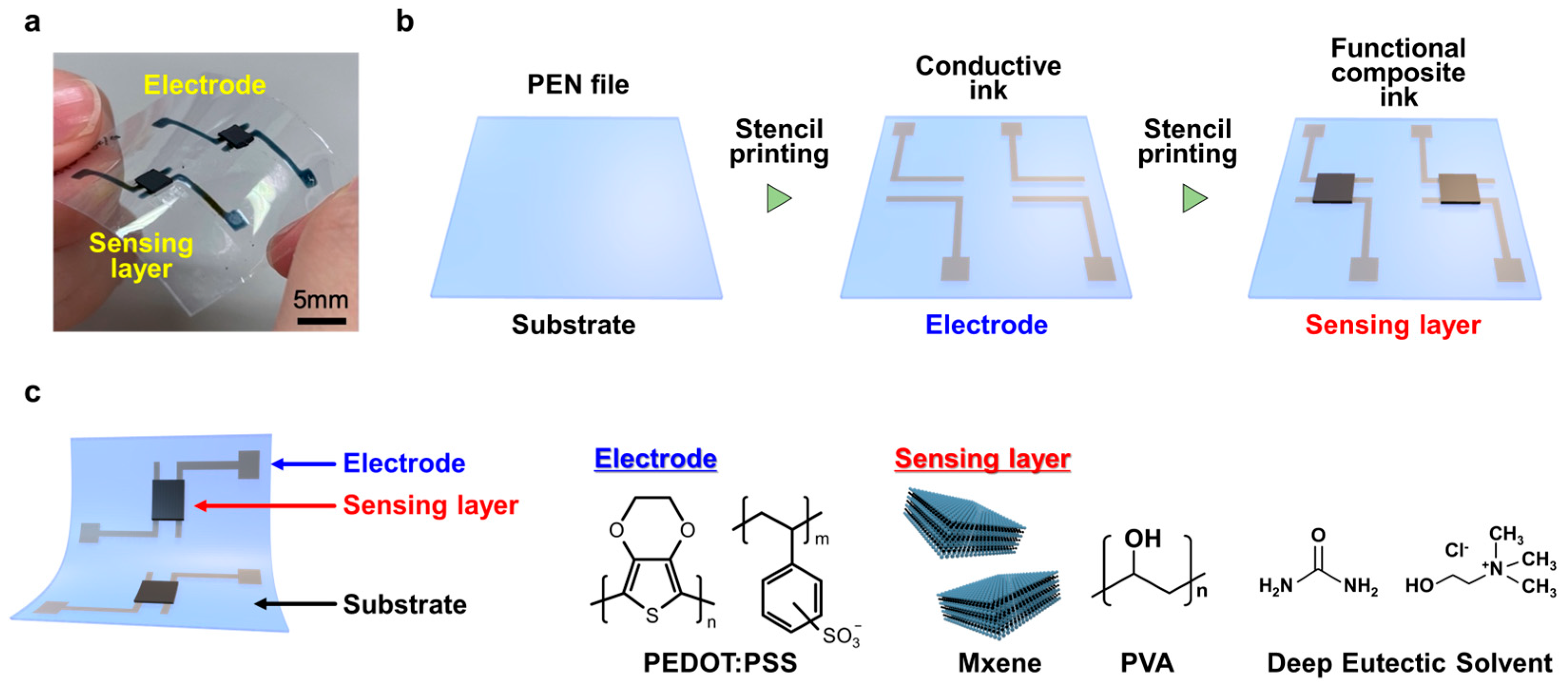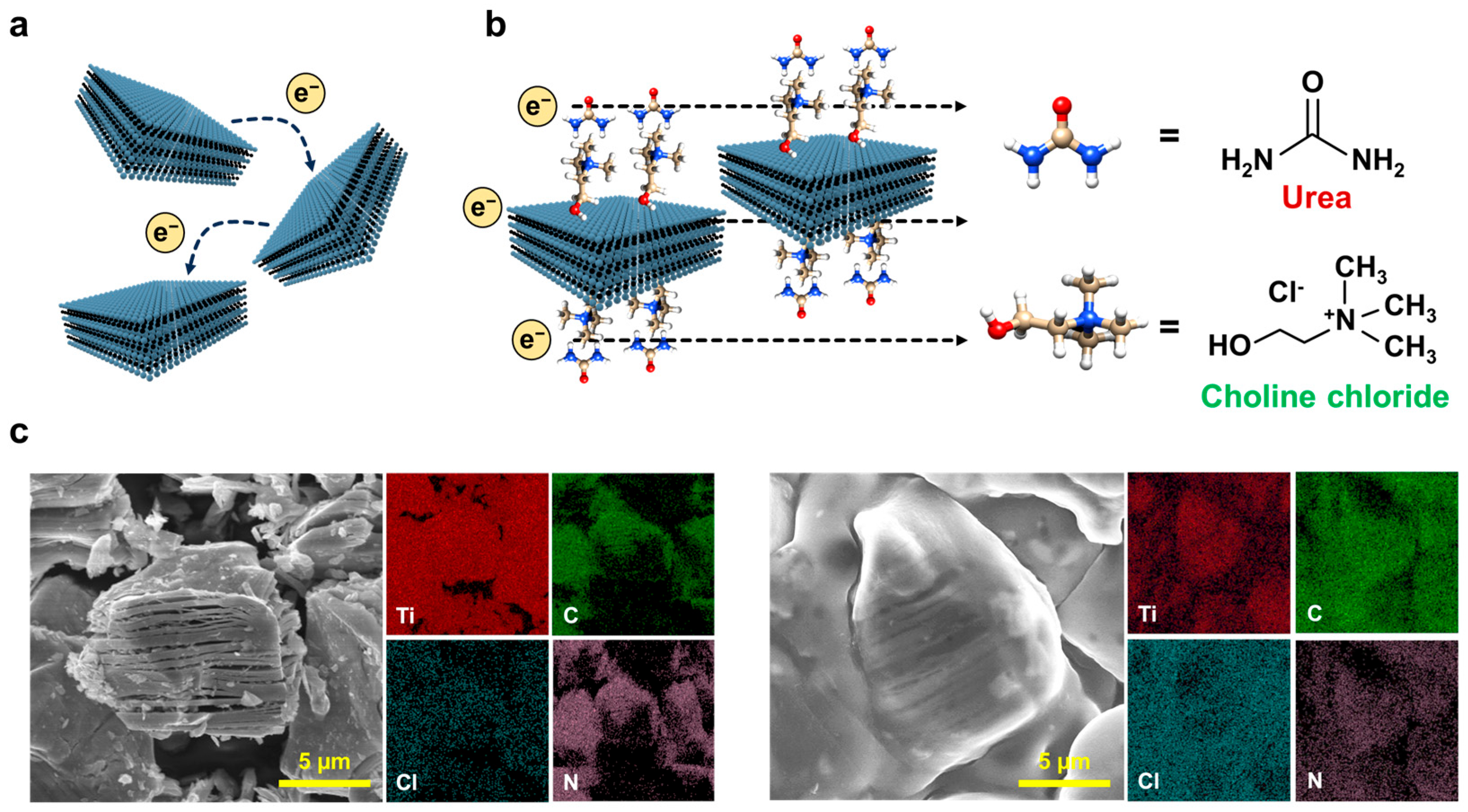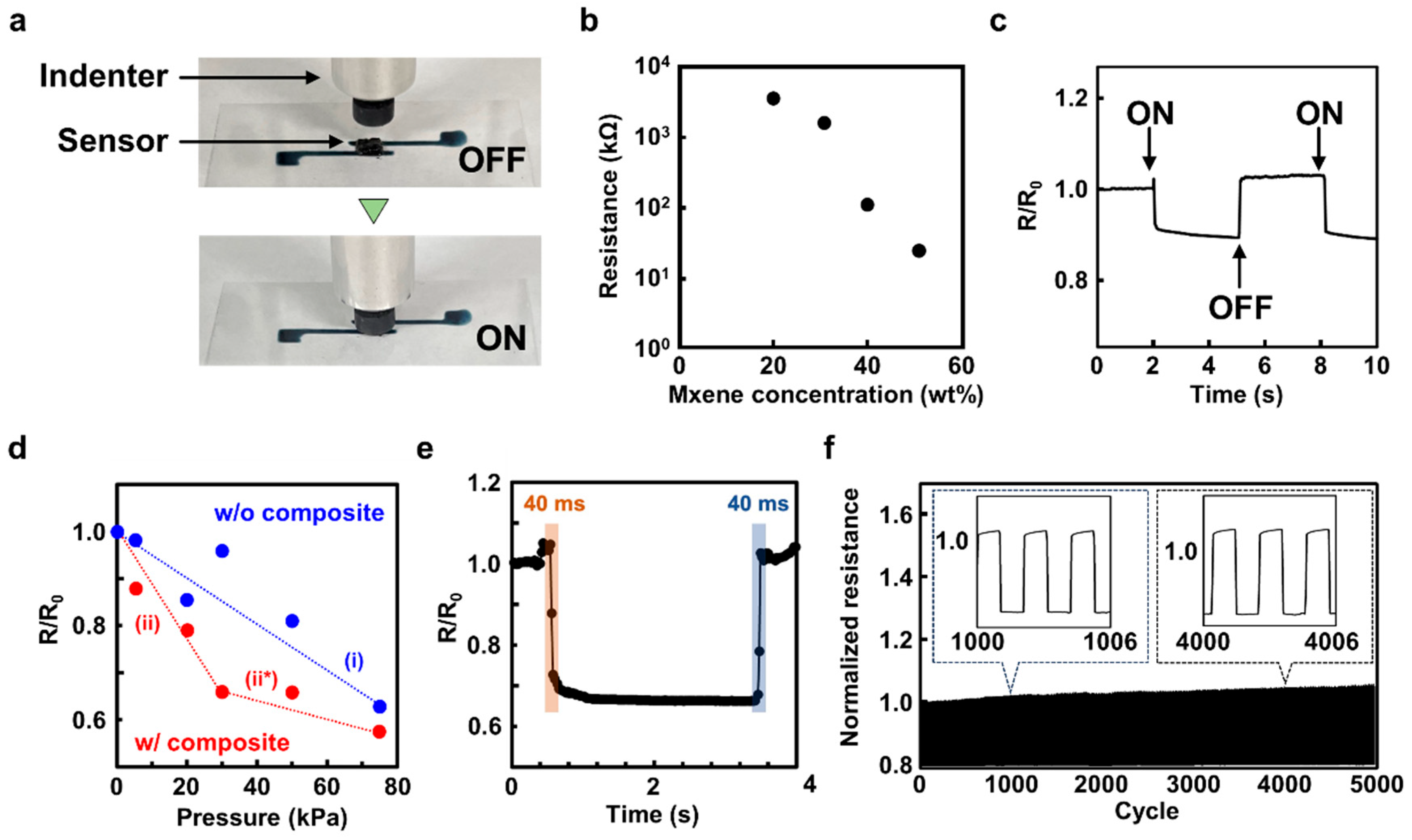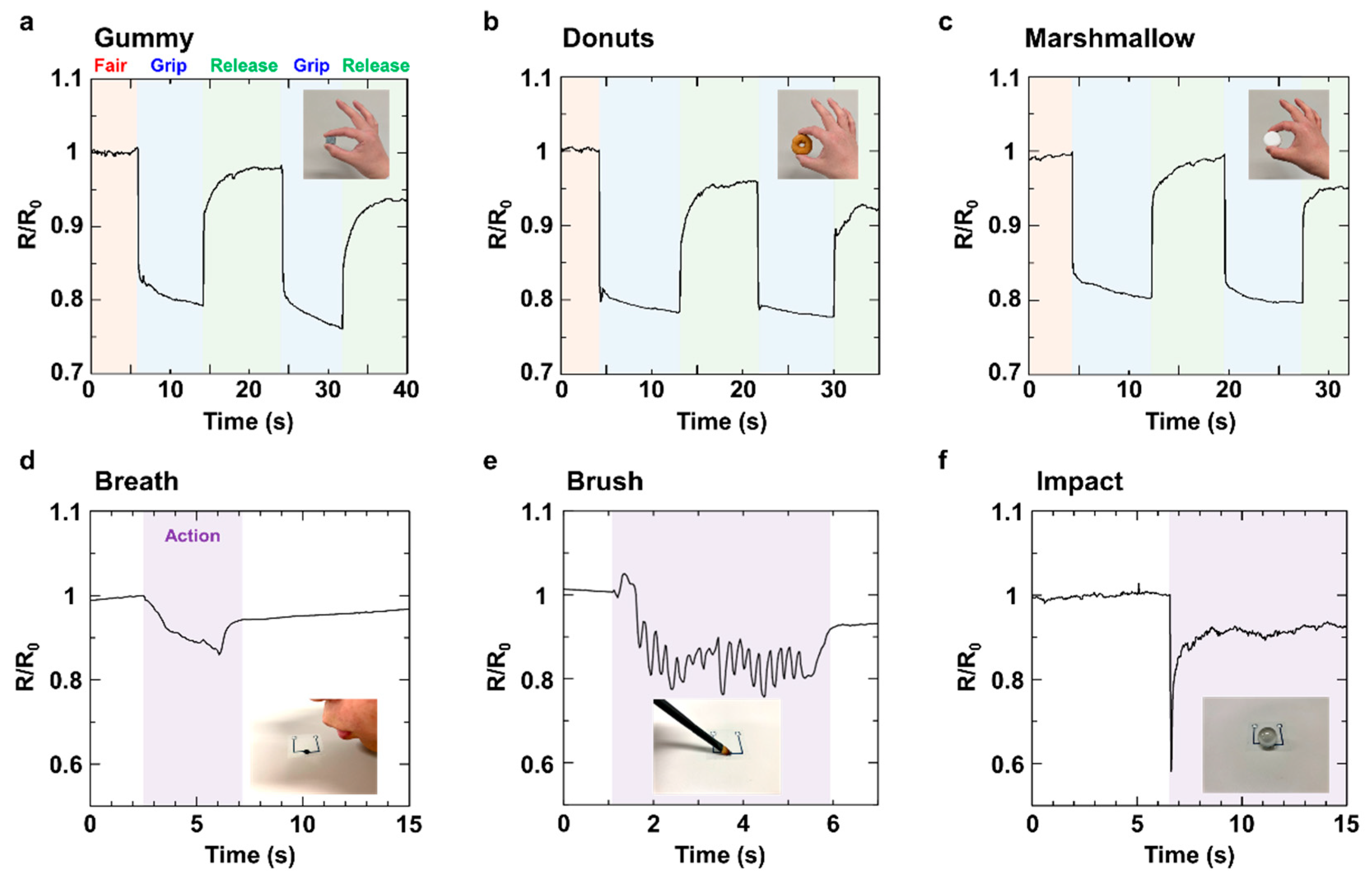MXene-Based High-Performance Soft Pressure Sensor Using Gel–Deep Eutectic Solvent Composite
Abstract
1. Introduction
2. Materials and Methods
3. Results
4. Discussion
5. Conclusions
Supplementary Materials
Author Contributions
Funding
Data Availability Statement
Acknowledgments
Conflicts of Interest
Abbreviations
| DES | Deep Eutectic Solvent |
| FT-IR | Fourier Transform Infrared Spectroscopy |
| PEN | Polyethylene Naphthalate |
| PDMS | Polydimethylsiloxane |
| PVA | Polyvinyl Alcohol |
| PVP | Polyvinylphenol |
| SEM | Scanning Electron Microscope |
| XRD | X-Ray Diffraction |
References
- Li, X.; Huang, Z.; Shuck, C.E.; Liang, G.; Gogotsi, Y.; Zhi, C. MXene chemistry, electrochemistry and energy storage applications. Nat. Rev. Chem. 2022, 6, 389. [Google Scholar] [CrossRef]
- Mehrpooya, M.; Hadavand, M.; Ganjali, M.R. Exploring the synergistic potential: A comprehensive review of MXene-Based composite electrocatalysts. Mater. Chem. Phys. 2025, 332, 130076. [Google Scholar] [CrossRef]
- Sharma, S.; Chhetry, A.; Sharifuzzaman, M.; Yoon, H.; Park, J.Y. Wearable Capacitive Pressure Sensor Based on MXene Composite Nanofibrous Scaffolds for Reliable Human Physiological Signal Acquisition. ACS Appl. Mater. Interfaces 2020, 12, 22212. [Google Scholar] [CrossRef] [PubMed]
- Chaudhary, V.; Ashraf, N.; Khalid, M.; Walvekar, R.; Yang, Y.; Kaushik, A.; Mishra, Y.K. Emergence of MXene–Polymer Hybrid Nanocomposites as High-Performance Next-Generation Chemiresistors for Efficient Air Quality Monitoring. Adv. Funct. Mater. 2022, 32, 2112913. [Google Scholar] [CrossRef]
- Li, K.; Zhao, J.; Zhussupbekova, A.; Shuck, C.E.; Hughes, L.; Dong, Y.; Barwich, S.; Vaesen, S.; Shvets, I.V.; Möbius, M.; et al. 4D printing of MXene hydrogels for high-efficiency pseudocapacitive energy storage. Nat. Commun. 2022, 13, 6884. [Google Scholar] [CrossRef] [PubMed]
- Bashir, T.; Zhou, S.; Yang, S.; Ismail, S.A.; Ali, T.; Wang, H.; Zhao, J.; Gao, L. Progress in 3D-MXene Electrodes for Lithium/Sodium/Potassium/Magnesium/Zinc/Aluminum-Ion Batteries. Electrochem. Energy Rev. 2023, 6, 5. [Google Scholar] [CrossRef]
- Sharma, S.; Chhetry, A.; Maharjan, P.; Zhang, S.; Shrestha, K.; Sharifuzzaman, M.; Bhatta, T.; Shin, Y.; Kim, D.; Lee, S.; et al. Polyaniline-nanospines engineered nanofibrous membrane based piezoresistive sensor for high-performance electronic skins. Nano Energy 2022, 95, 106970. [Google Scholar] [CrossRef]
- Wang, Y.; Wang, Y.; Jian, M.; Jiang, Q.; Li, X. MXene Key Composites: A New Arena for Gas Sensors. Nano Micro Lett. 2024, 16, 209. [Google Scholar] [CrossRef]
- Lin, C.; Song, X.; Ye, W.; Liu, T.; Rong, M.; Niu, L. Recent Progress in Optical Sensors Based on MXenes Quantum Dots and MXenes Nanosheets. J. Anal. Test. 2024, 8, 95. [Google Scholar] [CrossRef]
- Zhang, Y.Z.; Wang, Y.; Jiang, Q.; El-Demellawi, J.K.; Kim, H.; Alshareef, H.N. MXene Printing and Patterned Coating for Device Applications. Adv. Mater. 2020, 32, 1908486. [Google Scholar] [CrossRef]
- Matias, M.L.; Pereira, C.; Almeida, H.V.; Jana, S.; Panigrahi, S.; Menda, U.D.; Nunes, D.; Fortunato, E.; Martins, R.; Nandy, S. 3D printed MXene architectures for a plethora of smart applications. Mater. Today Adv. 2024, 23, 100512. [Google Scholar] [CrossRef]
- Wu, Z.; Liu, S.; Hao, Z.; Liu, X. MXene contact engineering for printed electronics. Adv. Sci. 2023, 10, 2207174. [Google Scholar] [CrossRef] [PubMed]
- Kim, J.; Campbell, A.S.; de Ávila, B.E.F.; Wang, J. Wearable biosensors for healthcare monitoring. Nat. Biotechnol. 2019, 37, 389. [Google Scholar] [CrossRef]
- Isano, Y.; Takaya, M.; Kurotaki, Y.; Matsuda, R.; Miyake, Y.; Takano, T.; Isoda, Y.; Hamagami, T.; Kuribayashi, K.; Ota, H. Soft intelligent systems based on stretchable hybrid devices integrated with machine learning. Device 2024, 2, 100496. [Google Scholar] [CrossRef]
- Sekine, T.; Wang, Y.F.; Hong, J.; Takeda, Y.; Miura, R.; Watanabe, Y.; Abe, M.; Mori, Y.; Wang, Z.; Kumaki, D.; et al. Artificial Cutaneous Sensing of Object Slippage using Soft Robotics with Closed-Loop Feedback Process. Small Sci. 2021, 1, 2100002. [Google Scholar] [CrossRef] [PubMed]
- Ryu, S.; Lee, P.; Chou, J.B.; Xu, R.; Zhao, R.; Hart, A.J.; Kim, S.G. Extremely Elastic Wearable Carbon Nanotube Fiber Strain Sensor for Monitoring of Human Motion. ACS Nano 2015, 9, 5929. [Google Scholar] [CrossRef]
- Sekine, T.; Abe, M.; Muraki, K.; Tachibana, S.; Wang, Y.F.; Hong, J.; Takeda, Y.; Kumaki, D.; Tokito, S. Microporous Induced Fully Printed Pressure Sensor for Wearable Soft Robotics Machine Interfaces. Adv. Intell. Syst. 2020, 2, 2000179. [Google Scholar] [CrossRef]
- Gibney, E. The inside story on wearable electronics. Nature 2015, 528, 26. [Google Scholar] [CrossRef]
- Long, S.; Feng, Y.; He, F.; Zhao, J.; Bai, T.; Lin, H.; Cai, W.; Mao, C.; Chen, Y.; Gan, L.; et al. Biomass-derived, multifunctional and wave-layered carbon aerogels toward wearable pressure sensors, supercapacitors and triboelectric nanogenerators. Nano Energy 2021, 85, 105973. [Google Scholar] [CrossRef]
- Yang, Z.; Li, H.; Zhang, S.; Lai, X.; Zeng, X. Superhydrophobic MXene@carboxylated carbon nanotubes/carboxymethyl chitosan aerogel for piezoresistive pressure sensor. Chem. Eng. J. 2021, 425, 130462. [Google Scholar] [CrossRef]
- Tang, Z.; Jia, S.; Zhou, C.; Li, B. 3D Printing of Highly Sensitive and Large-Measurement-Range Flexible Pressure Sensors with a Positive Piezoresistive Effect. ACS Appl. Mater. Interfaces 2020, 12, 28669. [Google Scholar] [CrossRef] [PubMed]
- Ntagios, M.; Nassar, H.; Pullanchiyodan, A.; Navaraj, W.T.; Dahiya, R. Robotic Hands with Intrinsic Tactile Sensing via 3D Printed Soft Pressure Sensors. Adv. Intell. Syst. 2020, 2, 1900080. [Google Scholar] [CrossRef]
- Yasuda, T.; Komine, R.; Nojiri, R.; Takabe, Y.; Nara, K.; Kaneko, T.; Horigome, S.; Takeda, Y.; Wang, Y.F.; Kawaguchi, S.; et al. Ultra-Rapidly Responsive Electret-Based Flexible Pressure Sensor via Functional Polymeric Nanoparticle Synthesis. Adv. Funct. Mater. 2024, 34, 2402064. [Google Scholar] [CrossRef]
- Liu, L.; Yang, J.; Zhang, H.; Ma, J.; Zheng, J.; Wang, C. Recent advances of flexible MXene physical sensor to wearable electronics. Mater. Today Commun. 2023, 35, 106014. [Google Scholar] [CrossRef]
- Du, T.; Han, X.; Yan, X.; Shang, J.; Li, Y.; Song, J. MXene-Based Flexible Sensors: Materials, Preparation, and Applications. Adv. Mater. Technol. 2023, 8, 2202029. [Google Scholar] [CrossRef]
- Achkar, T.E.; Greige-Gerges, H.; Fourmentin, S. Basics and properties of deep eutectic solvents: A review. Environ. Chem. Lett. 2021, 19, 3397. [Google Scholar] [CrossRef]
- Sharma, S.; Pradhan, G.B.; Chhetry, A.; Shrestha, K.; Bhatta, T.; Zhang, S.; Kim, D.; Jeong, S.; Shin, Y.; Zahed, M.A.; et al. Graphene-polymer nanocomposites electrode with ionic nanofibrous membrane for highly sensitive supercapacitive pressure sensor. Nano Today 2023, 48, 101698. [Google Scholar] [CrossRef]
- Lou, Z.; Chen, S.; Wang, L.; Jiang, K.; Shen, G. An ultra-sensitive and rapid response speed graphene pressure sensors for electronic skin and health monitoring. Nano Energy 2016, 23, 7. [Google Scholar] [CrossRef]
- Tou, K.; Nara, K.; Sekine, T.; Wang, Y.F.; Takeda, Y.; Kumaki, D.; Tokito, S. Micro-Pore Composed Soft Pressure Sensor with Ether-Surfactant via High-Sensitivity in Wide Range for Robotic Machine Interface Application. Adv. Sensor Res. 2023, 2, 2300045. [Google Scholar] [CrossRef]
- Wang, Y.F.; Sekine, T.; Takeda, Y.; Hong, J.; Yoshida, A.; Matsui, H.; Kumaki, D.; Nishikawa, T.; Shiba, T.; Sunaga, T.; et al. Printed Strain Sensor with High Sensitivity and Wide Working Range Using a Novel Brittle–Stretchable Conductive Network. ACS Appl. Mater. Interfaces 2020, 12, 35282. [Google Scholar] [CrossRef]
- Adelnia, H.; Ensandoost, R.; Moonshi, S.S.; Gavgani, J.N.; Vasafi, E.I.; Ta, H.T. Freeze/thawed polyvinyl alcohol hydrogels: Present, past and future. Eur. Polym. J. 2022, 164, 110974. [Google Scholar] [CrossRef]
- Tomé, L.I.N.; Baião, V.; da Silva, W.; Brett, C.M.A. Deep eutectic solvents for the production and application of new materials. Appl. Mater. Today 2018, 10, 30. [Google Scholar] [CrossRef]
- Sekine, T.; Sugano, R.; Tashiro, T.; Sato, J.; Takeda, Y.; Matsui, H.; Kumaki, D.; Domingues dos Santos, F.; Miyabo, A.; Tokito, S. Fully Printed Wearable Vital Sensor for Human Pulse Rate Monitoring using Ferroelectric Polymer. Sci. Rep. 2018, 8, 4442. [Google Scholar] [CrossRef]
- Wan, S.; Chen, Y.; Huang, C.; Huang, Z.; Liang, C.; Deng, X.; Cheng, Q. Scalable ultrastrong MXene films with superior osteogenesis. Nature 2024, 634, 1103. [Google Scholar] [CrossRef]
- Xu, J.; Zhang, L.; Lai, X.; Zeng, X.; Li, H. Wearable RGO/MXene Piezoresistive Pressure Sensors with Hierarchical Microspines for Detecting Human Motion. ACS Appl. Mater. Interfaces 2022, 14, 27262. [Google Scholar] [CrossRef]
- Li, W.D.; Ke, K.; Jia, J.; Pu, J.H.; Zhao, X.; Bao, R.Y.; Liu, Z.Y.; Bai, L.; Zhang, K.; Yang, M.B.; et al. Recent Advances in Multiresponsive Flexible Sensors towards E-skin: A Delicate Design for Versatile Sensing. Small 2022, 18, 2103734. [Google Scholar] [CrossRef]
- Wang, X.; Dong, L.; Zhang, H.; Yu, R.; Pan, C.; Wang, Z.L. Recent Progress in Electronic Skin. Adv. Sci. 2015, 2, 1500169. [Google Scholar] [CrossRef]
- Nakamura, H.; Honda, S.; Matsumura, G.; Wakabayashi, S.; Uehara, K.; Nakajima, K.; Takei, K. Flexible electronic brush: Real-time multimodal sensing powered by reservoir computing through whisker dynamics. Sci. Adv. 2025, 11, eads4388. [Google Scholar] [CrossRef]





Disclaimer/Publisher’s Note: The statements, opinions and data contained in all publications are solely those of the individual author(s) and contributor(s) and not of MDPI and/or the editor(s). MDPI and/or the editor(s) disclaim responsibility for any injury to people or property resulting from any ideas, methods, instructions or products referred to in the content. |
© 2025 by the authors. Licensee MDPI, Basel, Switzerland. This article is an open access article distributed under the terms and conditions of the Creative Commons Attribution (CC BY) license (https://creativecommons.org/licenses/by/4.0/).
Share and Cite
Sasaki, R.; Tou, K.; Kamanoi, S.; Yoshida, J.; Takabe, Y.; Miura, Y.; Kamiya, E.; Hirayama, A.; Sekine, T. MXene-Based High-Performance Soft Pressure Sensor Using Gel–Deep Eutectic Solvent Composite. Micromachines 2025, 16, 579. https://doi.org/10.3390/mi16050579
Sasaki R, Tou K, Kamanoi S, Yoshida J, Takabe Y, Miura Y, Kamiya E, Hirayama A, Sekine T. MXene-Based High-Performance Soft Pressure Sensor Using Gel–Deep Eutectic Solvent Composite. Micromachines. 2025; 16(5):579. https://doi.org/10.3390/mi16050579
Chicago/Turabian StyleSasaki, Riku, Kaiin Tou, Shoma Kamanoi, Junya Yoshida, Yoshihito Takabe, Yasuyuki Miura, Eri Kamiya, Ayana Hirayama, and Tomohito Sekine. 2025. "MXene-Based High-Performance Soft Pressure Sensor Using Gel–Deep Eutectic Solvent Composite" Micromachines 16, no. 5: 579. https://doi.org/10.3390/mi16050579
APA StyleSasaki, R., Tou, K., Kamanoi, S., Yoshida, J., Takabe, Y., Miura, Y., Kamiya, E., Hirayama, A., & Sekine, T. (2025). MXene-Based High-Performance Soft Pressure Sensor Using Gel–Deep Eutectic Solvent Composite. Micromachines, 16(5), 579. https://doi.org/10.3390/mi16050579





